Dell XPS M1710 - GeForce Go 7900 GTX 512 Mobile Gaming, Part 1
by Jarred Walton on April 18, 2006 9:00 AM EST- Posted in
- Laptops
General System Performance
Winstones 2004 and the PCMark products provide a reasonable look at overall system performance (minus games). Honestly, any modern dual core system is basically "fast enough" when it comes to these tasks. Anyone looking to buy an XPS system would have to be interested in gaming, or at least some more graphics intensive applications, or else they would be far better off ditching the high-powered graphics chip. Still, let's see how the systems compare.
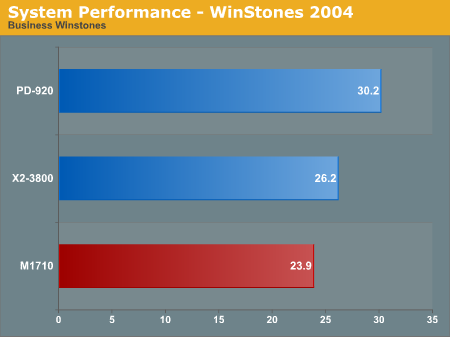
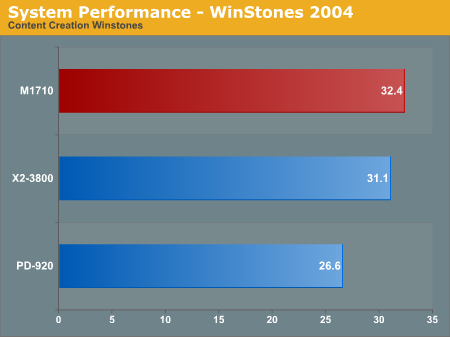

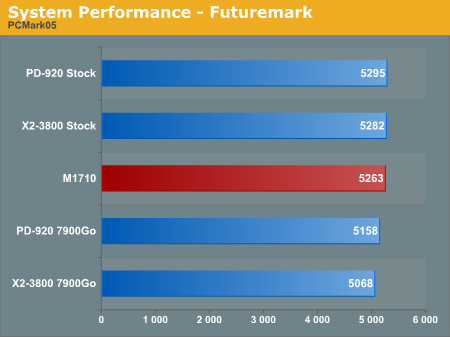
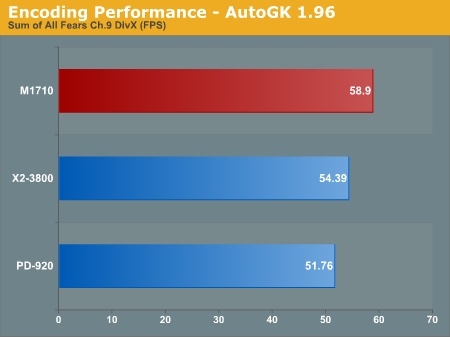
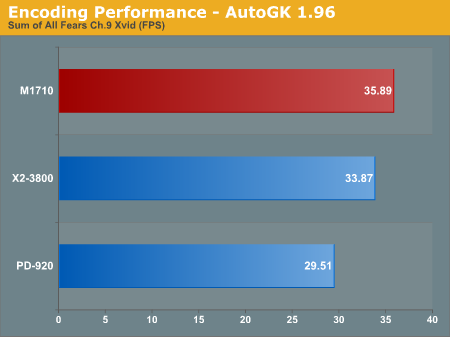
The M1710 delivers an impressive start, basically winning five of the six tests. The only benchmark that it doesn't win is Business Winstones, where it finishes last place. That particular test has very little that will take advantage of multiple processors, and of all the tests we'll run today, it represents applications that are most dependent on user input. PCMark05 has the M1710 in the middle of the pack, but the faster graphics cards of the desktop systems are the only thing keeping it from a first-place finish.
Winstones 2004 and the PCMark products provide a reasonable look at overall system performance (minus games). Honestly, any modern dual core system is basically "fast enough" when it comes to these tasks. Anyone looking to buy an XPS system would have to be interested in gaming, or at least some more graphics intensive applications, or else they would be far better off ditching the high-powered graphics chip. Still, let's see how the systems compare.






The M1710 delivers an impressive start, basically winning five of the six tests. The only benchmark that it doesn't win is Business Winstones, where it finishes last place. That particular test has very little that will take advantage of multiple processors, and of all the tests we'll run today, it represents applications that are most dependent on user input. PCMark05 has the M1710 in the middle of the pack, but the faster graphics cards of the desktop systems are the only thing keeping it from a first-place finish.










69 Comments
View All Comments
JarredWalton - Thursday, April 20, 2006 - link
I received the following email, and thought the response would be useful for others:-----------
Thank you for the informative article on the Dell Gaming system. I was curious on if you know how this Laptop: http://www.sagernotebook.com/pages/go_np5950.html">http://www.sagernotebook.com/pages/go_np5950.html would stack up to the Dell system. I am thinking of purchasing a gaming laptop and would like to know if you have had any experience with the sager systems vs. the Dell systems. Would the SLI in the sager give me twice the performance of the Dell?
-----------
I haven't used the Sager system, but let me just provide the few comments looking at the specs.
First, SLI pretty much never gives you twice the performance, and on that system it has the older 7800 GTX cards instead of the new 7900 GTX card. That means that the cards are clocked slower. Going along with that, 7800 cards are built using a 110 nm process, while the 7900 is built using a 90 nm process. The smaller process results in lower power requirements and thus lower heat out. The end result is that I'm sure the Sager system will be hotter, and while it might be a bit faster I'm not sure it's worth it. There are other issues I see as well.
Dual core Athlon 64 processors compete very well with Intel's Core Duo processors. AMD Turion processors are at present only single core. That may not matter a whole lot right now, but I would again give the advantage to the M1710.
In terms of size, that Sager system is a real beast. 15 pounds with a battery pack means it's about 50% heavier than the Dell. That may not matter much to you, but I certainly wouldn't want to have to carry that laptop around a lot. Periodically toting it between two locations would be fine, but hauling that thing around a trade show or university campus wouldn't be my idea of a good time.
Finally, the Sager system has a larger display (19 inch widescreen) but a lower resolution. The Dell system can run practically any game (*NOT* FEAR and Oblivion struggles at times with maximum detail setttings) at native resolution with a single 7900 GTX card. If you're going to have a 15 pound "laptop" then you might as well have a 1920x1200 resolution as well. It also ships default with 1 GB of RAM and a smaller, slightly slower hard drive.
When I look at all the aspects together, as well as the final price, that particular system doesn't look like a great deal -- and besides, it's still in preorder status. I'm sure there will be 7900 SLI laptops available shortly, so if you really want the added heat and add performance of SLI, that's what I would wait for. I would also insist on some form of dual core processor, but that's personal preference.
Regards,
Jarred Walton
Hardware Editor
AnandTech.com
Anemone - Sunday, April 23, 2006 - link
Further comparison thoughts vs the SLI system:I will reinforce that dual core is going to be more and more useful in the coming year, even in games. If you online game, which can run other comm processes in the background it is already useful to have dual cores.
64 bit dual core by dropping in Merom is going to add 20-30% to your 1710's ability. Expensive yes, but damn nice to know.
This laptop series from the Gen2 to the M170 and now this, have a decent track record of at least one gpu upgrade, sometimes two. It is entirely likely (watch the news as it comes if I'm wrong I apologize) that you'll see the current Gen2/170 series be able to go to the 7900GTX. It is not illogical to think that the 1710 should be able to go to the G80. There aren't enough details yet to say what the G80 will give you, but the ability to add Merom and the likely ability to go one next generation GPU up is a fantastic (albeit expensive) ability to have in a gaming laptop.
4gb of memory limit. The SLI machine has only 2 as the limit. Even then it may well drop timings at 2gb to 2T (unsure). Even if it does not, when Vista comes out 2gb is going to feel like cramped. The Vista OS can eat as much as 800mb of your memory for the OS alone, and we haven't even seen the memory footprint of DX10/WGF 2.x. For a regular user, this is a liveable issue and thus most machines at 2gb limit will be ok. But for a gamer, the experience could be very frustrating, as hardrive memory extension in the laptop arena is sloooowwwwwww. So 4gb is another reason to go with the 1710, not for right now, but for later.
Heat kills. Dual SLI is going to be pretty toasty. Ask anyone who has a P4 based notebook and they can tell you that over time, the extra heat eventually kills parts of the machine. There is a long time user satisfaction reason that Dell and others have gone the way of Centrino coupled with a single high end GPU like the 7800/7900. The heat can be controlled and keeps it from getting nasty with other components. This has the effect of allowing the entire system to live longer, especially since gamers are rarely the type to pick up their laptop and use it for 20 min then shut it down, lol. Long use, upping the heat levels and long term durability/reliability are good partners with low heat production, another pick that says the 1710 is better than the SLI machine.
$.02
Anemone - Sunday, April 23, 2006 - link
I'm sorry for some of the bad wording above. I didn't reread carefully enough. :(RichUK - Wednesday, April 19, 2006 - link
Is this supposed to be a mobile platform, lol...Also, those lights need to be stripped out straight away!!
timmiser - Thursday, April 20, 2006 - link
Nah, keep the lights. The lights are my favorite part! This is a gaming laptop so if you're looking for something a bit more formal and energy effecient, don't look at this baby.coster - Wednesday, April 19, 2006 - link
You guys have a Dell 3007wfp 30" in the house you can test on the unit to see if it Dual link video card? The 7900 GO's plzzz :)JarredWalton - Wednesday, April 19, 2006 - link
No. :( ASAIK, it is single-link only, but I'm trying to get confirmation from Dell for Pt. 2.spinportal - Wednesday, April 19, 2006 - link
Can someone explain or point me to web references on which is faster and why?DDR2-533 @ 4-4-4-12 timings
vs.
DDR2-667 @ 5-5-5-15 timings
I would think the DDR2-533 would be better, but I need a proof.
spinportal - Wednesday, April 19, 2006 - link
The reason I state this is simple; the author failed to produce timing specs for the DDR2-667 for the M1710. Come on, its 5-5-5-15, put it up as its labeled on the SODIMM or CPU-Z reports it as.JarredWalton - Wednesday, April 19, 2006 - link
The installed DDR2 is actually rated at:3-3-3-9 DDR2-400
4-4-4-12 DDR2-533
5-5-5-15 DDR2-667
It is running at 5-5-5-15 at present (not sure if the BIOS will allow me to change that). However, think in terms of latency.
200 MHz base speed with 3 cycle latency = 15 ns
266 MHz base speed with 4 cycle latency = 15 ns
333 MHz base speed with 5 cycle latency = 15 ns
Given that latencies are the same in all three cases, the added bandwidth ought to offer a slight performance increase. I would guess the difference is at best 2%, though, and often less than even that.